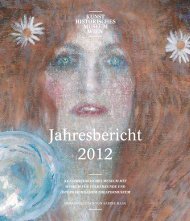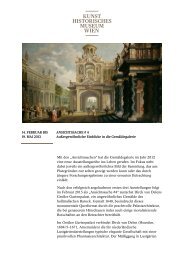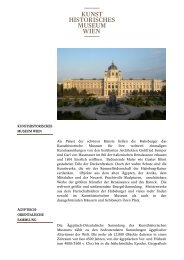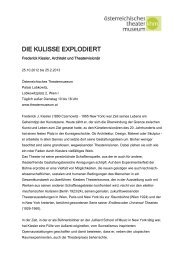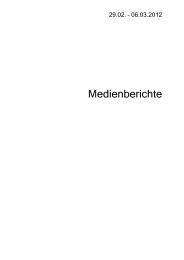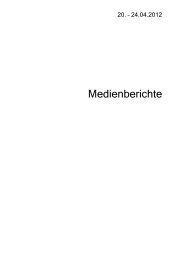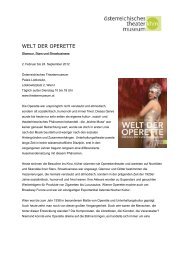Jahresbericht 2011 - Presse - Kunsthistorisches Museum Wien
Jahresbericht 2011 - Presse - Kunsthistorisches Museum Wien
Jahresbericht 2011 - Presse - Kunsthistorisches Museum Wien
Erfolgreiche ePaper selbst erstellen
Machen Sie aus Ihren PDF Publikationen ein blätterbares Flipbook mit unserer einzigartigen Google optimierten e-Paper Software.
190<br />
khm, museum oF ethnology and austrIan theatre museum, <strong>2011</strong><br />
archIVes, puppet theatre, bagatelles and<br />
paIntIng<br />
Besides research on various new cases and the documentation<br />
of the reverse sides of paintings in the picture<br />
collection, the work of the archives concentrates on the<br />
objects in the collections of Mathilde and oskar Strnad,<br />
as well as those of eva Henriette and Margarethe<br />
Sonnenthal. in addition a data bank on the documentation,<br />
administration and exploration of provenience<br />
characteristics was evolved.<br />
photography collectIon<br />
Almost 10,000 photos were entered into the TMS.<br />
Approximately 6000 photos were digitalised.<br />
drawIngs<br />
The Art for Art costume workshops made a major<br />
donation comprising about 2000 costume figurines from<br />
the years 1960 to 2000 from the Viennese federal<br />
theatres; such valuable pieces as designs by Jean-Pierre<br />
Ponnelle or Achim Freyer were among them.<br />
lIbrary<br />
The project THEO – Theatre bill Online was carried<br />
out in the context of the university course Library and<br />
Information Studies (MSc) 2010/<strong>2011</strong>. The majority of<br />
the 19th-century theatre bills in the Austrian Theatre<br />
<strong>Museum</strong>’s library were checked for completeness and<br />
registered in an online data bank.<br />
restoratIon<br />
Besides supervising loans for exhibitions, the textile and<br />
paper restoration department was mainly preoccupied<br />
with preparations for moving items from the collection<br />
to the new depot.<br />
the museum and the publIc<br />
The diverse range of offers was enriched by two longerterm<br />
projects entitled Bretter, die die Welt bedeuten –<br />
selbst gestalten, and Über den eigenen Schatten springen<br />
organised in the context of the educational initiative<br />
“Arts education for Schools in Federal <strong>Museum</strong>s in<br />
<strong>2011</strong>”, sponsored by the Federal Ministry of education,<br />
Art and culture, with additional consultation by the<br />
organisation KulturKontakt Austria.<br />
exhIbItIons<br />
dürer – cranach – holbein<br />
The Discovery of Man: the German Portrait around 1500<br />
31 May to 4 September <strong>2011</strong><br />
<strong>Kunsthistorisches</strong> <strong>Museum</strong><br />
Main Building<br />
16 September <strong>2011</strong> to 15 January 2012<br />
Kunsthalle der Hypo-Kulturstiftung, München<br />
After over five hundred years the exhibition ventured to<br />
follow the traces of Albrecht Dürer and his most famous<br />
artist colleagues Lucas cranach and Hans Holbein the<br />
Younger. The early German art of painting portraits had<br />
never before been the subject of a major public exhibition<br />
devoted specifically to that theme. outstanding<br />
works of art show how, around 1500, the human being<br />
shifted to the centre of artistic interest, and artists became<br />
discoverers and inventors of the human picture.<br />
For a long time old Dutch or italian portrait art overshadowed<br />
the view of the German contributions to the<br />
subject. Yet it was precisely German portrait painting,<br />
whose greatest exponents were Albrecht Dürer, Lucas<br />
cranach the elder, and Hans Holbein the Younger who<br />
made significant and very individual artistic achievements,<br />
whose particular strength lies in the authentic<br />
rendition of a person, coupled with the subtle psychological<br />
perception of the person portrayed. Moreover,<br />
the portraits on display conveyed an insight into late<br />
Mediaeval and early modern society as we encounter the<br />
depicted persons in their explicit social roles.<br />
winter tales<br />
Depictions of Winter in european Art from<br />
Brueghel to Beuys<br />
18 october <strong>2011</strong> to 8 January 2012<br />
<strong>Kunsthistorisches</strong> <strong>Museum</strong><br />
Main Building<br />
impressionist art, Dutch painting and a great variety of<br />
landscape depictions – these were the ingredients of the<br />
few exhibitions mounted so far on the theme of winter.<br />
These three successful components have now been considerably<br />
extended by the <strong>Kunsthistorisches</strong> <strong>Museum</strong> in<br />
cooperation with the Zurich Kunsthaus. Going beyond<br />
genre definitions and national borders a broad-ranging<br />
selection of 180 western european works of art were<br />
presented. The chronological sequence of the works<br />
extended from 1450 to the present. Besides depictions<br />
of need and misery in the winter, as well as carefree,<br />
exuberant scenes including pictures of ice-skaters on<br />
frozen lakes and rivers, the exhibition also showed Dutch<br />
allegories of the months, scenes of winter festivities and<br />
customs as well as still life paintings. even portraits were<br />
included as they gave an insight into the relevant winter<br />
fashion. The selection of paintings was further enhanced<br />
by large-scale tapestries and a grand carousel sleigh, and<br />
also with trophies, delicate china figures and precious<br />
stone-cut objects. However, the main highlight came<br />
from the <strong>Kunsthistorisches</strong> <strong>Museum</strong>’s own possessions:<br />
the painting by Pieter Bruegel the elder entitled<br />
Hunters in the Snow is probably the most famous picture<br />
of winter in the western history of art.<br />
terribly beautiful<br />
Monstrosities in Art<br />
(intermezzo 03)<br />
15 February to 1 May <strong>2011</strong><br />
<strong>Kunsthistorisches</strong> <strong>Museum</strong><br />
Main Building<br />
al-Fann<br />
Art from the islamic civilisation from<br />
the al-Sabah collection, Kuwait<br />
22 March to 19 June <strong>2011</strong><br />
<strong>Kunsthistorisches</strong> <strong>Museum</strong><br />
Main Building<br />
Jan Fabre<br />
The Years of the Hour Blue<br />
4 May to 28 August <strong>2011</strong><br />
<strong>Kunsthistorisches</strong> <strong>Museum</strong><br />
Main Building<br />
gods, man and money in ancient greece<br />
21 June to 26 october <strong>2011</strong><br />
<strong>Kunsthistorisches</strong> <strong>Museum</strong><br />
Main Building<br />
5 november <strong>2011</strong> to 27 May 2012<br />
coin cabinet of the city of Winterthur<br />
“everything has turned out very nicely …”<br />
(emperor Franz Joseph)<br />
120 Years of the <strong>Kunsthistorisches</strong> <strong>Museum</strong><br />
18 october <strong>2011</strong> to 8 January 2012<br />
<strong>Kunsthistorisches</strong> <strong>Museum</strong><br />
Main Building<br />
renessenz<br />
Facets of the renaissance<br />
8 november <strong>2011</strong> to 15 April 2012<br />
<strong>Kunsthistorisches</strong> <strong>Museum</strong><br />
Main Building<br />
“heaven is Full of Violins”<br />
The Violin in the Biedermeier and romantic Periods<br />
14 April to 25 September <strong>2011</strong><br />
<strong>Kunsthistorisches</strong> <strong>Museum</strong><br />
neue Burg<br />
drink and be merry!<br />
Bacchus hosts a party<br />
7 April to 31 May <strong>2011</strong><br />
Ambras castle<br />
all’antica<br />
Gods & Heroes at Ambras castle<br />
23 June to 25 September <strong>2011</strong><br />
Ambras castle




